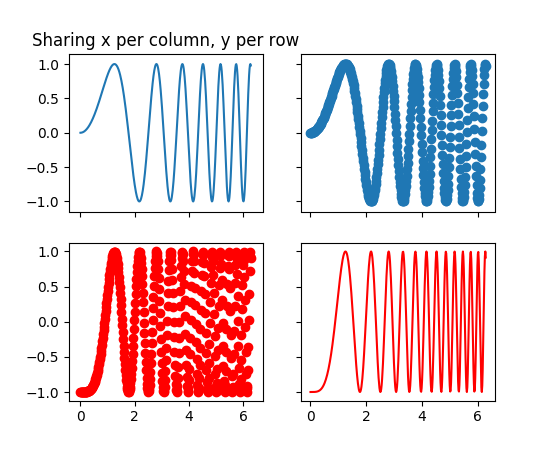

Now we will see how to work with two plots within one figure. The axes are the actual plots so that a figure can have multiple plots. You can think of that as that whole window that shows us when we run our code. In Matplotlib, the figure is the container holding our plots.
#SUBPLOT MATPLOTLIB PYTHON CODE#
The following code example is a single line-plot in Matplotlib.Įxample Code: import matplotlib.pyplot as pltĬreate Two Subplots in One Direction With Matplotlib We will create dependent and independent list variables (x and y coordinates) for the x1 and y1 variables with numeric data. This parameter accepts a tuple with width and height. The following code subplots() method takes the figsize parameter. In the next subsection, we’ll look at how to create multiple plots in one figure. We have not defined how many rows and columns should be created in a figure because this is the single plot example for basic understanding with Matplotlib. The first is a figure, and the second is an axis to create subplots on different axes. The subplots() method helps create multiple plots in a single window or figure, and this method returns two things. Use the 'seabourn' style for these plots to look slightly better. import matplotlib.pyplot as pltĪfter importing matplotlib.pyplot. To create plots, we will import matplotlib.pyplot the alias as "plt" using the following code. It happens multiple times when you are trying to plot multiple subplots, so you find it very difficult to work with loops and automate plotting multiple plots. Create a Plot Using the subplots() Method in Matplotlib In this tutorial, you’ll learn to work with the subplot functionality provided with the matplotlib package to create and display multiple plots in one figure in Python. Many people prefer to create their plots this way, even if they only create a single plot. If you want additional plots or work with more object-oriented plots, it is best to create your plots with the subplots method. Create Multiple Subplots in One Figure in Matplotlib.Create Two Subplots in One Direction With Matplotlib.Create a Plot Using the subplots() Method in Matplotlib.This results in the two charts placed side-by-side but spread farther apart. (Write to us at if you know the answer to this.)įig, axis = plt.subplots(1,2,figsize=(15,5)) So, we may have to call this a documentation bug for now. The Matplotlib documentation says this is given in inches, but it’s not, as the chart below will show the same size regardless of the size of your monitor-and why would a system used by people around the world not use the metric system? This seems to be a relative size. Note: There is something not clear here.Add figsize meaning width and heights, respectfully. fig, axis = plt.subplots(1,2,figsize=(15,5)) meaning 1 row and 2 columns.Note that we plot sin(x) in the top chart and cos(x) in the bottom to avoid graphing the same data twice. Now, plot two charts, one stacked on top of the other. Use the right-hand menu to navigate.) Vertically stacked figures (This article is part of our Data Visualization Guide. Annotate the chart by labelling each axis with plt.ylabel(‘sin(x)’) and plt.xlabel(‘x’).The y axis will range between 1 and -1 since the sin function np.sin(x) ranges between 1 and -1.The function np.arange(0,25,0.1) creates 250 numbers ranging from 0 to 25 in increments of 0.1.Matplotlib will then autofit the chart to our data. Start by plotting one chart onto the chart surface.


 0 kommentar(er)
0 kommentar(er)
